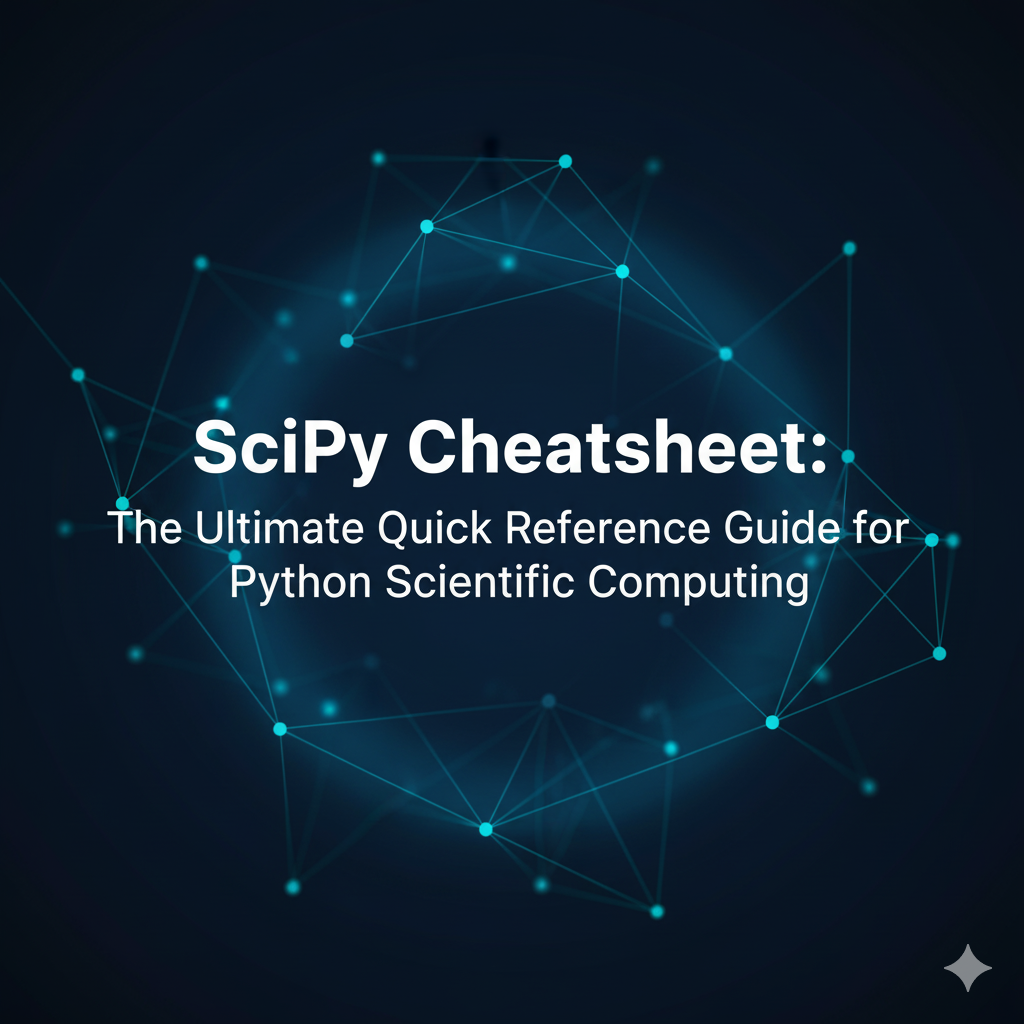When working with scientific computing, mathematics, data analysis or optimization in Python, the SciPy library is one of the most powerful tools you can use. Built on top of NumPy, SciPy extends its functionality with specialized modules for linear algebra, optimization, signal processing, integration, interpolation and more.

Table of Contents
This SciPy Cheatsheet serves as a quick reference guide for beginners and professionals. It includes the most commonly used functions and workflows along with explanations and code snippets.
What is SciPy?
SciPy (Scientific Python) is an open-source library for scientific computing. It builds on NumPy arrays and provides advanced functions for:
- Numerical integration and differentiation
- Linear algebra and sparse matrices
- Optimization and root finding
- Signal and image processing
- Statistics and probability distributions
If NumPy is the foundation, SciPy is the toolbox that expands your mathematical and scientific capabilities in Python.
1. Installation & Setup
pip install scipy
import numpy as np
from scipy import linalg, optimize, stats, integrate, interpolate, signal
You can install SciPy with pip and import only the modules you need. SciPy is modular, so you don’t need to load the entire library every time.
2. Linear Algebra (scipy.linalg)
A = np.array([[3, 2], [1, 4]])
# Determinant
linalg.det(A)
# Inverse
linalg.inv(A)
# Eigenvalues and Eigenvectors
vals, vecs = linalg.eig(A)
# Solve Ax = b
b = np.array([5, 6])
x = linalg.solve(A, b)
Linear algebra is at the core of data science and ML. With scipy.linalg, you can compute determinants, inverses, eigenvalues and solve systems of equations. This is essential in areas like machine learning, physics simulations and control systems.
3. Optimization (scipy.optimize)
# Minimize a function
f = lambda x: x**2 + 10*np.sin(x)
result = optimize.minimize(f, x0=2)
# Root finding
root = optimize.root(lambda x: x**3 - 2*x - 5, x0=2)
# Solve linear least squares
A = np.array([[1, 2], [3, 4]])
b = np.array([1, 2])
lsq = optimize.lsq_linear(A, b)
The optimize module helps with mathematical optimization minimizing functions, finding roots and solving least squares. These are commonly used in machine learning model fitting, physics problems and engineering design.
4. Integration & Differentiation (scipy.integrate)
# Single integral
result, error = integrate.quad(lambda x: np.exp(-x**2), 0, np.inf)
# Double integral
dbl, _ = integrate.dblquad(lambda y, x: x*y, 0, 1, lambda x: 0, lambda x: 1)
# Solve ODE
from scipy.integrate import solve_ivp
def dy_dx(t, y): return -2*y
sol = solve_ivp(dy_dx, [0, 5], [1])
Integration lets you compute areas under curves, while ODE solvers help simulate systems like population growth, chemical reactions or physics models.
5. Interpolation (scipy.interpolate)
x = np.linspace(0, 10, 10)
y = np.sin(x)
# 1D interpolation
f = interpolate.interp1d(x, y, kind='cubic')
print(f(5.5))
# 2D interpolation
x2 = np.linspace(0, 4, 4)
y2 = np.linspace(0, 4, 4)
z = np.outer(x2, y2)
f2 = interpolate.interp2d(x2, y2, z, kind='linear')
print(f2(2, 2))
Interpolation estimates unknown values between known data points. This is useful in data cleaning, filling missing values, and signal/image reconstruction.
6. Signal Processing (scipy.signal)
t = np.linspace(0, 1, 500)
sig = np.sin(2*np.pi*50*t) + np.sin(2*np.pi*120*t)
# Fourier Transform
freq, power = signal.periodogram(sig)
# Filtering
b, a = signal.butter(4, 0.2)
filtered = signal.filtfilt(b, a, sig)
# Convolution
conv = signal.convolve([1, 2, 3], [0, 1, 0.5])
Signal processing tools allow Fourier transforms, filtering, and convolution. They’re widely used in audio processing, biomedical signals (ECG, EEG) and sensor data analysis.
7. Statistics & Probability (scipy.stats)
# Descriptive stats
data = np.random.randn(1000)
mean, var, skew, kurt = stats.describe(data)
# Normal distribution
pdf = stats.norm.pdf(0)
cdf = stats.norm.cdf(0)
# Hypothesis testing
t_stat, p_val = stats.ttest_1samp(data, 0)
The stats module helps analyze datasets. You can compute descriptive statistics, work with probability distributions and perform hypothesis testing, which is essential in data science, research and A/B testing.
8. Sparse Matrices (scipy.sparse)
from scipy.sparse import csr_matrix
A = csr_matrix([[0, 0, 1], [1, 0, 0], [0, 0, 2]])
print(A)
# Matrix operations
A.T.todense()
A.dot(A.T).todense()
Sparse matrices save memory and computation time when working with data that contains lots of zeros (e.g., graphs, NLP term-document matrices).
9. Fourier Transforms (scipy.fft)
from scipy import fft
x = np.array([1, 2, 3, 4])
y = fft.fft(x)
inv = fft.ifft(y)Fourier transforms convert signals between time and frequency domains. This is crucial in audio analysis, vibration monitoring and communications engineering.
10. Image Processing (scipy.ndimage)
from scipy import ndimage
# Rotate, zoom, and filter
img = np.random.rand(5, 5)
rotated = ndimage.rotate(img, 45)
blurred = ndimage.gaussian_filter(img, sigma=1)
ndimage provides basic image processing tools like filtering, rotation, and zooming useful in computer vision and preprocessing.
11. Curve Fitting
from scipy.optimize import curve_fit
def func(x, a, b):
return a * np.exp(-b * x)
x = np.linspace(0, 4, 50)
y = func(x, 2.5, 1.3) + np.random.normal(0, 0.2, len(x))
params, cov = curve_fit(func, x, y)Curve fitting matches mathematical functions to data, commonly used in modeling experimental results.
12. Clustering & Spatial Data (scipy.spatial)
from scipy.spatial import distance
a = [1, 2]
b = [4, 6]
dist = distance.euclidean(a, b)
from scipy.spatial import KDTree
tree = KDTree(np.random.rand(10, 2))
print(tree.query([0.5, 0.5]))
spatial handles geometric and spatial algorithms. KD-Trees are efficient for nearest neighbor search, useful in machine learning, recommendation systems and computational geometry.
Conclusion
This SciPy Cheatsheet is your quick reference guide for scientific computing in Python. From linear algebra and optimization to interpolation, statistics and signal processing, SciPy provides a full toolbox for researchers, engineers and data scientists.
Keep this SciPy Cheatsheet bookmarked and use it whenever you need fast access to SciPy’s most useful methods.
Related Reads
- PyTorch Cheatsheet: The Ultimate Quick Reference for Beginners and Developers
- The Ultimate TensorFlow Cheatsheet: From Basics to Advanced
- Applied Machine Learning – CS 5785 at Cornell Tech: Complete Course Guide
- NLP Text Preprocessing Cheatsheet 2025: The Ultimate Powerful Guide
- Plotly Cheatsheet 2025: Powerful Techniques from Beginner to Advanced

3 thoughts on “SciPy Cheatsheet: The Ultimate Quick Reference Guide for Python Scientific Computing”